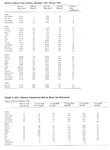parsifal
Colonel
How did this compare with the US:Japenese?
It depends on the situation. In open warfare, the standard Japanese Infantry Army (sort of a Corps strength unit) lacked the artillery firepower to fight a stand up fight against the western armies. Their armour in 1942 was equal to our own in quality, but Japanese armoured doctrine as a mass attack weapon was very poor. The japanese, however at the beginning of the war excelled at armoured warfare in the Jungle, or rough terrain.where the norm was to fight in small numbers.
In situations where the Japanese retained some semblance of a logistic support network, the lack of experience in the US field formations showed up very badly. When asked to engage in outright offensive warfare, such as at Gona and Sanananda, the US combat formations just fell apart, much as they did in Europe. We in the west have been brought up on an unhealthy and innaccurate view of the IJA based on a very narrow and quite unique experience on Guadacanal. One needs to look at the variable at work that led to the guadacanal fiasco. No reall suly, always short of food and ammunition, no real artillery support, attacking unsupported against a determined enemy well led and well dug in, at no stage attempting to really counterattack, in terrain heavily favouring the defence. This produced a predictably heavy defeat for the Japanese. Moreover for the remainder of the warthe US always ensured that battles against the Japanese that the defenders were well isolated and unsupported first, and then used their far superiuor firepower levels to blast out the defending Japanese. As straight up Infantry the Japanese were still superior, but in terms of supply and fire support they were just too ill-equipped to be competitive.
Give the Japanese a 6 month respite, not fight Midway, allow the Japanese time to organise their convoy systems and the story would be completely different.
There arent fpf comparisons that I know for the Japanese, though I bet they exist somewhere. But imagine if it were US formations attacking at Guadacanal and Japanese with the secure supply lines and dug in. Instead of fighting doggedly for 4 months as the Japanese did, I give a US formation in a similar situation about a fortnight......

